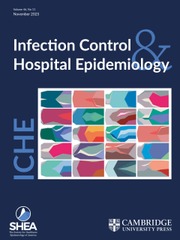To the Editor—Mosquito-borne infections are increasingly important. To control mosquito-borne infections, mosquito control is needed. The Aedes mosquito is an important vector for many diseases including the Zika virus and dengue fever. The survey of Aedes mosquito larva is a routine public health practice in tropical countries.Reference Benelli and Mehlhorn 1 Mosquito larvae can be found in many urban buildings. Hospitals can also be the setting of habitat for the Aedes mosquito, but this fact is mentioned infrequently. Here, I report and discuss the data from an Aedes mosquito larva survey in hospitals in an endemic area of Thailand (western region, 7 provinces) during the rainy season, May–June 2015. Overall, 30 hospitals were surveyed, and Aedes mosquito vector larva were detected in 16 hospitals (53.3%). The percentage of water-holding containers infested with larvae ranged from 0 to 30. The number of larvae-positive containers per 100 containers inspected at hospitals, the Breteaux index, ranged from 0 to 20.59. Based on these data, many hospitals can be considered the source for Aedes-borne infectious disease. Indeed, an important role of the medical center is to provide health care to and promote health within the community. Mosquito control in the hospital is usually a forgotten issue, but it can pose a significant problem if there is a healthcare-associated outbreak of mosquito-borne infection in the region. In the era of emerging and remerging mosquito-borne infections (eg, Zika virus infection, dengue and others), mosquito control in the hospital is necessaryReference Wiwanitkit 2 and represents an emerging and important issue in the field of infection control and hospital epidemiology.
No CrossRef data available.


